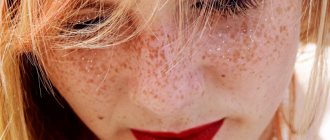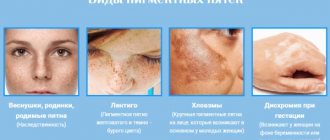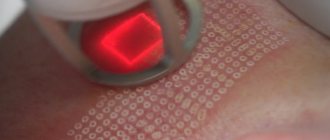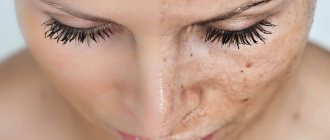Pigmentation after laser pigmentation removal is a fairly common problem. Usually, laser therapy is performed by a specially trained specialist who works only with the device, and the problem of pigmentation after the laser has to be solved by a cosmetologist.
Why it occurs and how to avoid it in the article below.
To understand why age spots appear after laser removal, you need to understand what happens in the skin in response to laser exposure.
Care after laser pigment spot removal
After the procedure, the patient can go home immediately. But it is necessary to follow the rules of rehabilitation:
- During the first 24 hours after the laser, it is unacceptable for water to come into contact with the treated areas. You can't put on makeup or wash your face.
- For 2 weeks, it is prohibited to use cosmetics containing alcohol, exfoliate, use a hard washcloth, or expose pigmented areas to UV radiation.
- The crusted area of skin is treated with disinfecting and healing preparations prescribed by the doctor. To combat dryness, apply a moisturizing cream with a non-aggressive composition. The skin will finally heal after 1 month. The crust ideally disappears on its own and does not leave behind scars or scars.
- Be sure to use a cream with a sun protection factor of 30 or higher. You cannot visit the bathhouse, solarium, sauna and swimming pool. In the summer, you should wear a wide-brimmed hat when outdoors. Summer is generally a less suitable period for laser procedures precisely because of the sun. It is better to sign up for sessions in autumn and winter.
Care after laser pigment spot removal is mandatory.
Correction of post-traumatic pigmentation after aggressive laser procedures
Bragina Irina Yurievna, candidate of medical sciences, dermatologist, cosmetologist, physiotherapist, gerontologist.
Expert instructor of the European Laser Academy of Health LA&HA, vice-president of the Medical Laser Academy of Russia (MLAR), member of the American Society of Laser Medicine and Surgery (ASLMS), member of the Society of Aesthetic Medicine of Russia (OEM), specialist in the field of laser technologies and rehabilitation. Scientific director of the laser direction and curator of the Fotona brand of the SportMedImport Group of Companies. Post-inflammatory hyperpigmentation (PIH)
is the most common acquired pigmentation disorder. The prevalence and intensity of this aesthetic problem are associated with the cause, duration and intensity of inflammation preceding pigmentation.
Post-inflammatory hyperpigmentation is darkening of the skin that occurs after an inflammatory rash or skin trauma. This condition is the result of a response of melanocytes to skin damage, which causes an increase in melanin production and/or its redistribution.
Pathogenesis of PIH
Hyperpigmentation has the following development mechanism. Inflammatory processes in the dermis and epidermis lead to the release and oxidation of arachidonic acid with the formation of prostaglandins, leukotrienes, etc. These inflammatory factors damage the functioning of immune cells and melanocytes. Depending on the depth of the lesion, epidermal or dermal melanosis develops.
The epidermal form of post-inflammatory pigmentation is characterized by increased production and transport of melanin into surrounding keratinocytes. Clinically, the deposition of melanin granules results in darkening of the skin. The intradermal form of PIH results from inflammation-induced damage to basal keratinocytes, which secrete large amounts of melanin. The free pigment is phagocytosed in the upper dermis by macrophages, now called melanophages, and gives the skin a blue-gray appearance at the site of injury.
Other factors in the formation of PIH:
- the influence of UV radiation, which provokes tyrosinase-dependent melanogenesis. Melanomas are transferred to keratinocytes;
- genetics, taking medications, antibiotics. In these cases, melanostimulating hormone is released, which leads to increased sensitivity of the skin to UV;
- endocrinopathies, COCs (estrogen), pregnancy. The production of tyrosinase is activated, resulting in increased melanin synthesis.
Women are several times more likely to develop PIH than men. The role of the endocrine and immune systems in the development of post-traumatic pigmentation
The formation of PIH largely depends on the functioning of the immune and endocrine systems. Stress hormones play a significant role in the formation of post-traumatic pigmentation. Corticotropin stimulates the secretion of adrenocorticotropic hormone from the pituitary gland and cortisol. In addition, under its influence, hormones of the sympathetic nervous system are released from the nerve ganglia and nerve endings. Under stress, the concentration of androgenic hormones in the blood increases. Testosterone causes spasm of skin blood vessels in areas with a high content of receptors. There is a deterioration in local tissue reactivity. These processes, even with minor trauma or inflammation of the skin, can lead to chronic inflammation and the appearance of keloid scars.
Stress has a suppressive effect on the immune system, mainly due to an increase in the concentration of glucocorticoids. They inhibit the production of a number of pro-inflammatory cytokines (IL1, IL6, TNFa, etc.), reduce the number of circulating lymphocytes, macrophages and basophils, and with long-term exposure cause apoptosis of lymphocytes and thymic atrophy.
In depression, there is an excess of cortisol secretion in the adrenal cortex.
This hormone cannot affect the hypothalamus and pituitary gland and stop the production of stress hormones. The immune system turns out to be weakened, since for a long time all the body’s forces were thrown into overcoming a stressful situation, neglecting the interests of the immune system. The influence of hormones on processes in the skin
| Corticosteroids and pituitary adrenocorticotropic hormone | Inhibits the mitotic activity of fibroblasts, but accelerates their differentiation |
| Mineralocorticoids | Strengthen the inflammatory response, stimulate the development of all elements of connective tissue, accelerate epithelization |
| Somatotropic hormone of the pituitary gland | Enhances cell proliferation, collagen formation, granulation tissue formation |
| Thyroid hormones | Stimulates the metabolism of connective tissue cells and their proliferation, the development of granulation tissue, collagen formation and wound healing |
| Sex hormones (estrogens) | Lack of hormones slows down reparative processes |
| Sex hormones (androgens) | Activate fibroblast activity |
Hormonal imbalance leads to deterioration of microcirculation and a decrease in the skin's ability to regenerate.
Consequences of these processes:
- decreased elasticity of vascular walls and increased permeability. This prolongs the period of edema after the procedure;
- dysfunction of neurohumoral regulation, which causes persistent vasodilation. These processes lead to blood stasis;
- expansion of the capillaries of the superficial vascular network, which triggers the development of erythema, vascular mesh, telangiectasia;
- increasing the period of wound epithelization.
Prevention of PIH formation:
- Careful collection of anamnesis (and its recording in the patient’s chart)
- Avoidance of active work with high parameters in patients of phototypes III – IV
- Mandatory use of sunscreen after any procedures involving skin trauma
- Controlling the prescription of medications with photosensitizing properties
To prevent PIH, substances that perform the following functions are used:
- prevention of post-inflammatory hyperpigmentation (anti-inflammatory, antiseptic, astringent effect). Tranexamic acid and fern extract (Fernblok) are used;
- protection from UV radiation, which stimulates the development of pigmentation (sunscreens);
- antioxidant effect. It is provided by: fern extract (Fernblok),
- procyanidin (vitamin P, catechins);
- interference in the hormonal regulation of melanogenesis.
- The use of hardware technologies (LLLT, LED, MCT, UST) helps prevent post-inflammatory hyperpigmentation and also has an antioxidant effect on the skin.
Preparing to work with post-traumatic pigmentation
The preparatory period before PIH correction is especially important when working with patients at risk:
- smokers;
- patients in a state of hormonal, vitamin, microelement deficiency;
- persons experiencing chronic stress;
- patients with a symptom complex of microcirculation disorders (edema).
Objectives of the preparatory period:
1. Reducing the patient’s rehabilitation time:
- restoration of microcirculation;
- strengthening antioxidant status;
- control of inflammation.
2. Reducing the risk of side effects and complications after laser procedures:
- increasing immunity;
- improvement of microcirculation;
- increased antioxidant status;
- normalization of melanogenesis.
3. Increasing the efficiency of procedures:
- increase in the amount of “addressed” chromophore;
- reduction in the number of competitive chromophores;
- introduction of specialized sensitizers.
In the process of preparing for the correction of PIH, external agents, pharmacotherapy, physical factors, and injection methods are used. Their tasks:
- increased antioxidant status;
- activation of collagen synthetic function;
- decreased skin reactivity;
- prevention of pigmentation.
Patient management: choice of technologies taking into account the phase of the wound process Patient management at the acute stage
| Technology | AFT (warm and hot modes) | Peeling (warm and hot modes) |
| Wound process phase | Old phase |
| Objectives of the rehabilitation period | Control of the inflammatory process, formation of crusts, maintaining a moist environment in the wound, protection against infection |
| Form of medicine | Aerosols, sprays, gels, emulsions, balms, dressings |
| Means by mechanism of action | — Reparative and wound-healing drugs. - Painkillers. - Anti-inflammatory drugs. - Antiviral drugs. - Antioxidants. | — Reparative and wound-healing drugs. - Antiviral drugs. — Antibacterial drugs. - Anti-inflammatory drugs. - Antioxidants. |
Patient management at the acute stage of the wound process is carried out using open, closed and conditionally closed methods. When the wound surface becomes infected, the following drugs are used: Actovegin, Dioxyzol, Levosin, Levomekol, Mephenate, Acerbin, Olazol. The use of a low-intensity therapeutic infrared laser allows you to achieve the following results:
- reduction of intense swelling and tension in tissues;
- reducing the duration of inflammation phases;
- increasing the speed of blood flow and increasing the absorption of oxygen by tissues;
- decreased receptor sensitivity;
- an increase in the number of new vascular collaterals;
- activation of transport substances through the vascular wall;
- analgesia and inflammation relief;
- activation of blood microcirculation, increasing the level of trophic provision of tissues;
- stimulation of immunity and reparative processes;
- reflexogenic effect on the functional activity of various organs and systems;
- activation of cell metabolism, increasing their functional activity.
- Effects of using LILI
| DNA damage | Protein kinases involved in the formation of mRNA, as well as protein synthesis (RNA, DNA) are activated |
| Inflammation | The accumulation and release of ATP are activated. IL-6 mRNA levels decrease, modulation of PDGF, TGF-β, interleukins (IL-13 and IL-15, MMP), which are also associated with abnormal wound healing |
| Immunosuppression | There is an indirect effect on the cellular and humoral components of the immune system involved in antiviral reactions, and not a direct inactivating effect of the virus. Possible systemic inhibitory effect on delayed hypersensitivity reactions. Activation and proliferation of lymphocytes and macrophages, as well as the synthesis and expression of cytokines |
| Damage to the extracellular matrix | The increase in collagen production occurs due to an increasing effect on PDGF and fibroblast production, which occurs due to decreased apoptosis, increased vascular perfusion, bFGF and TGF-β. Decreasing IL-6 and increasing TIMPs, which in turn decrease MMPs, all help in reducing collagen degradation. Activation of ATP accumulation and release |
Management of a patient at the proliferative stage
| Requirements for the drug | AFL | Plane |
| Foam preparations, ointment forms |
Patient management at the reconstructive stage
| Requirements for the drug | AFL | Plane |
| Inflammatory phase | 3rd, remodeling phase |
| Form of medicine | Emulsions, creams |
| Objectives of the rehabilitation period | — High-quality restoration of the epidermis — Activation of metabolic and reparative processes in the dermis — Prevention of hyperpigmentation — Reduction of the severity of post-traumatic erythema — Restoration of TEWL |
| Means by mechanism of action | — Reparative — Antioxidant — Blocking melanin synthesis — Complex drugs |
Classification of pigmentation correction methods by mechanism of action:
- methods that reduce melanin production (depigmenting drugs, mesotherapy, oral agents);
- exfoliating procedures (peelings, microdermabrasion);
- those that destroy melanin (laser therapy, IPL (Intense Pulsed Light) therapy).
To lighten the skin and relieve inflammation, plant antioxidants and natural extracts are used.
The acceleration of exfoliation of keratinocytes with accumulated melanin is facilitated by the use of retinol, AHA acids, enzymatic peelings and ultrasound peeling. The main idea of these procedures is natural exfoliation of the skin without inflammation or suppression of this process. The role of photoprotection in the correction of post-traumatic pigmentation
To prevent the formation of pigmentation, patients must use sunscreen. Without the use of photoprotection, any procedures will have minimal effectiveness.
The following types of sunscreens are distinguished:
- chemical protection: Avobesin (UVA), Oxybenzone;
- physical protection: titanium dioxide, zinc oxide;
- combined protection (physical + chemical): Octyl methoxycinamate + zinc oxide, Parsol, Mexoril, Tinosorb S, M, Eusolex;
- natural filters: shea butter, caffeic acid, aloe, etc.;
- antioxidants;
- reparants (aloe, panthenol, hyaluronic acid).
To protect skin with post-traumatic pigmentation, sunscreens with a protection level of 30 or higher are suitable.
Patients are advised to avoid sunlight, as well as protect the skin with hats, clothing, and glasses. Depigmentation therapy: hardware methods
The use of laser technologies for the correction of PIH allows achieving clinical effects due to the absorption of light energy by skin chromophores. During the procedures, melanocytes are heated and damaged by thermal diffusion from heated melanosomes. The pigmented lesion darkens and peels off after 1-3 weeks.
Hardware technologies and features of their application
The use of Q-Switch lasers shows high efficiency in the treatment of PIH. They combine short (nanosecond) and ultrashort (picosecond) pulse durations. Features of picosecond lasers compared to nanosecond lasers are the impact on chromophores with a higher peak power and extremely short pulse duration. The duration of laser pulses for removing nanosized targets should be in the picosecond range. For this reason, picosecond laser processing allows for more efficient targeted energy transfer to significantly smaller chromophores. Picosecond pulses allow the use of lower fluences by enhancing the photoacoustic effect. This leads to a reduction in collateral damage due to less heating of surrounding tissues and less active formation of cavitation bubbles.
The absorption of a huge amount of energy in a short period of time leads to the implementation of a predominantly photoacoustic effect. The target "explodes" with the formation of many tiny "debris". In the case of using nanosecond lasers, results are also achieved mainly due to the photoacoustic effect. In this case, the energy of the target is transmitted over a longer period of time, due to which it is crushed into large fragments. Around the destroyed target chromophore in the epidermis or dermis, high-intensity zones of microdestruction are formed, caused by the impact of a “blast wave”. It is assumed that these areas of microtrauma are a trigger for the launch of remodeling processes in the dermal layer and the production of new collagen, mucin and elastin. These processes improve the condition of wrinkles and atrophic scars.
Fotona's StarWalker technology combines the high-energy capabilities of nanosecond lasers with the ultra-short pulse peak powers of traditional picosecond lasers. This combination allows you to influence a larger number of particles of different sizes than pico and nano separately. This feature increases the effectiveness of action on target tissues.
StarWalker's unique TMD (transverse mode) laser oscillator technology, combined with ASP pulse control, delivers very short (5 nsec) Q-switching pulses, consisting of a high-energy stream of ultra-short pulses of energy, in trillionths of a second.
This provides a photomechanical effect to break up tiny skin objects without damaging the surrounding skin. When using this device, handpieces with both full and fractional beams are used. High-energy capabilities of nanosecond lasers with ultrashort pulses peak powers of traditional picosecond lasers
When choosing the wavelength, they are guided by the principle of subcellular selective photothermolysis. In accordance with this principle, it is necessary to use high peak power and ultrashort pulse duration [5 ns]. This causes only the melanin in the target cell to be destroyed and leaves the cell alive. This technology is radically different from traditional treatment methods. They were based on the principle of selective photothermolysis, which leads to the destruction and death of pigment-containing cells.
The choice of laser radiation wavelength depends on the depth of melanin.
| Melanin depth | Clinical features |
| Epidermal | melanin in the basal and suprabasal layers of the epidermis; clear boundaries; light or dark brown color; Wood's lamp has clear contrast; responds well to treatment |
| Dermal | melanin granules in the dermis; unclear boundaries; gray-blue tint; in Wood's lamp the boundaries are not obvious; difficult to treat |
| Mixed | most common type; a combination of blue, light brown and dark spots; mixed painting in Wood's lamp; highly variable treatments |
StarWalker technology allows you to work with all possible wavelengths to correct post-traumatic pigmentation.
Advantages of StarWalker non-ablative Qs lasers:
- the ability to perform mild procedures that do not require anesthesia;
- very short skin recovery time;
- no side effects.
Fractional handpieces used:
FS20A (Nd:YAG);
- “spot” size: 10 x 10 mm;
- pixel size: 200 µm;
number of pixels: 81 (9 x 9 pixels). FS50 (KTP):
- “spot” size: 10 x 10 mm;
- pixel size: 200 µm;
- number of pixels: 25 (5 x 5 pixels).
FS50B (KTP):
- “spot” size: 5 x 5 mm;
- pixel size: 200 µm;
- number of pixels: 25 (5 x 5 pixels).
Principles of application of Q-Switch lasers
| Q-Switched Lasers (QSwitch) | Depth of exposure in accordance with the level of pigment occurrence | Special indications for use (types of hyperpigmentation) | Notes |
| KTP Nd:Yag laser 532 nm (frequency doubled neodymium (Nd:YAG) laser with wavelength 532 nm) | Epidermal layer of skin to basement membrane | Epidermal pigmentation: epidermal melasma; “café au lait” spots; lentigo | Radiation with a wavelength of 532 nm is well absorbed by oxyhemoglobin. After the procedure, bruising and purpura may appear, which completely disappear after 1-2 weeks |
| Ruby laser 694 nm with QSW (light skin only) | Upper dermis | Epidermal, dermal pigmentation: chloasma; lentigo; café au lait spots | I-II PHOTOTYPE Oxyhemoglobin does not act as a competing chromophore; there is no purpura or bruising after irradiation |
| Alexandrite laser (755 nm) with QSW (for very fair skin) | Middle departments | Epidermal, dermal pigmentation: melasma; chloasma; lentigo; “café au lait” spots; nevus of Ota; Becker's nevus | I-II –III PHOTOTYPE |
| Neodymium Nd:Yag laser 1064 nm with QSW (for all skin phototypes) | Deep layers of the dermis | Epidermal, dermal pigmentation: melasma; chloasma; lentigo; “café au lait” spots; nevus of Ota; Becker's nevus | I-IV-VI PHOTOTYPE |
Combination therapy in the treatment of PIH
Combination therapy shows higher effectiveness in correcting PIH than single use of individual drugs. For the treatment of melasma, the most widely used formula is Kligman's formula (HQ 5%, tretinoin 0.1% and Dexamethasone 0.1%). The combination of azelaic acid with 0.05% tretinoin or 15-20% glycolic acid can lead to earlier and more pronounced skin lightening . Kojic acid 2% in combination with HQ 2% is superior to glycolic acid 10% and HQ 2%. Glycolic acid 10% plus HQ 4% in a vitamin C and E cream and sunscreen was effective in 75% of patients.
The new combination of HQ 4%, tretinoin 0.05% and fluocinolone acetonide 0.01% (Tri-Luma®) was effective in 77% of patients.
Measures to prevent the formation of PIH:
- selection of adequate operating parameters (processing of skin without overlap; competently selected coverage area; selection of parameters corresponding to the impact zone);
- taking into account the general condition of the patients;
- correct choice of anatomical zone.
Proper preparation for laser procedures, taking into account the individual condition of the patient’s skin, as well as the use of suitable operating parameters, can effectively eliminate PIH and prevent its formation.
Treatment of complications
Complications often arise due to non-compliance with doctor’s recommendations after the procedure and violation of safety measures. The range of problems is as follows:
- If you remove the crusts yourself, microcracks and scars will form. Sometimes severe irritation and infection occur. It also happens that the treated pigment spot becomes inflamed, the temperature rises and the lymph nodes enlarge.
- With improper care, the following may appear: suppuration, necrosis, erythema, damage to healthy skin.
- Prolonged exposure to the sun can cause burns and re-pigmentation.
For these and any other complications, you should consult a doctor. He will select treatment and medications. Folk remedies will be used to assist therapy (but not instead of it).
Side effects of laser hair removal
Now let's move on to the side effects of laser and IPL hair removal procedures and their complications. Side effects of laser hair removal include pain, perifollicular swelling and erythema of the skin of the treated area. Perifollicular edema and erythema occur within a few minutes after exposure, resolve within a few hours and do not require treatment.
The severity of these reactions depends on the color, thickness and thickness of the hair, as well as on the density of the energy flow. Dark, thick hair absorbs a lot of energy during the procedure and becomes very hot, which can result in perifollicular edema and erythema. When affecting fine hair, perifollicular edema is usually less pronounced. Severe swelling also occurs in patients with sensitive, reactive skin. To reduce these side effects, it is important to use effective skin cooling systems before, during and, if required, after the procedure.
It is necessary to correctly select the energy flux density and, if necessary, gradually increase it until a clinical effect is achieved. If swelling and hyperemia are pronounced, then after the procedure you can prescribe a cream with glucocorticoids or dexpanthenol. For moderate and mild symptoms of perifollicular edema, it is enough to use soothing gels and creams at home, for example those used after sunbathing to relieve swelling and erythema.
As a means to promote regeneration, we can recommend the restorative ALOE GEL (MedicControlPeel, Russia) with a multivitamin complex and fireweed and chamomile extracts, as well as a hydroregulating gel for sensitive and irritated skin with dexpanthenol and hyaluronic acid Hydractive Mesaltera.
To quickly eliminate signs of inflammation, Cytobi GERnetic super-regenerating nourishing cream (France) is ideal. The exclusive formulation of the drug consists of five biological complexes containing amino acids, peptides, proteins, vitamins and trace elements. These components are necessary to launch the most important biochemical reactions of regeneration, moisturizing and nourishing the skin.
Immediately after the laser hair removal procedure, it is not recommended to carry out thermal and physiotherapeutic procedures, massage the treated areas, and you should not sunbathe.
Laser hair removal is not a painless procedure; Most patients experience pain during (or immediately after) it. To reduce pain, it is important to use an adequate method of cooling the skin and, if required, local external or infiltration anesthesia.
Do age spots come back after laser?
If all safety rules, contraindications and care recommendations are followed, stains should not return. Typically, re-pigmentation after laser procedures occurs due to constant exposure to the sun during the rehabilitation period. The patient goes outside without sunscreen, and UV rays affect the skin. The laser destroyed the hairs, and now the surface of the face is absolutely smooth and vulnerable to overheating, so it needs to be looked after especially carefully.
New spots are removed by repeated cosmetic procedures after a certain time. Whitening agents are also used. The following preventive measures are useful:
- careful selection of cosmetics, studying side effects before use;
- adding oatmeal, rosehip infusion, honey, melt water and fresh juices to the diet.
After laser treatment, there may be consequences for pigment spots due to an incorrect procedure or poor skin care. You need to approach the issue carefully: study the clinics and make sure that the cosmetologist is a professional, and also strictly monitor the spots after the session, and do not perform prohibited actions.
If negative consequences appear, for example, a red spot remains after the laser, you need to visit a doctor.
How to prepare for a laser procedure
The general rule that applies to laser treatments is to avoid tanning before the procedure. Patients should avoid going to the beach and solarium for at least four weeks before the session.
A laser beam, like sunlight, is light energy. Therefore, the combination of tanning and laser will overload the skin, which can lead to inflammation, irritation, prolongation of the recovery period and progression of the aging process.
The presence of a large amount of melanin pigment in the skin, which appears during tanning, can reduce the effectiveness of the laser and lead to the appearance of dark or light spots formed due to pigmentation disorders.
Pigmentation disorder
Laser processing steps
The doctor performs initial treatment with a laser beam, removing the surface layer of the epidermis
. After treatment, the facial skin becomes whitish. This means that the laser beam has affected the basement membrane. If local anesthesia was performed, the anesthetic cream is reapplied. After 5-10 minutes the procedure is repeated.
The procedure is carried out until damaged areas of facial skin are removed or until droplets of blood appear. This will indicate that the laser beam has penetrated the papillary or papillary layer of the dermis, which is located under the basement membrane and contains a large number of blood vessels and capillaries. It is at this level that an excellent effect is achieved, and the risk of complications is minimal.
After the procedure, a soothing mask
, consisting of absorbent, basalming and epithelializing components. With it, the recovery processes will go much faster. If classic deep facial resurfacing is performed, the patient can be left in the hospital for 2-3 days under the supervision of a doctor.
People with dark skin, allergies, and a tendency to poor healing of scars should be especially careful when performing the procedure. If there are contraindications or allergies, you should consult your doctor. After taking retinoids, you should wait 2-3 months before resurfacing.
Results of laser treatment
After polishing, deep wrinkles are smoothed out, and small ones completely disappear. The skin is tightened and age-related irregularities disappear. Already after the first procedure, the traces left from acne are noticeably reduced and pimples disappear. Collagen production is activated, so the skin becomes more elastic.
The procedure is done several times a year, this ensures maximum effect.
If the defects are pronounced, to completely eliminate them you will need to undergo a course of 3 or more procedures. The price of laser resurfacing depends on the financial policy of the cosmetology center; it ranges from 7 to 12 thousand rubles. In the capital, laser resurfacing will cost more. The recovery period after the procedure lasts from 2 to 4 weeks.
What to do on the day of the laser procedure
Make-up and skin care products should not be on the skin, as they can interfere. The cosmetologist additionally cleans the procedure site with special means to remove obstacles in the path of the laser beam.
After preparation, a specialist uses a special attachment to apply a laser to the face. Depending on the type of procedure, the impact can be deep or superficial. As a rule, the more serious the existing problems, the deeper the laser must be applied.
Effect of laser on skin
The procedure does not cause pain, since during deep exposure an anesthetic gel is applied to the treated surface. Only the heat, touch and light flashes of the laser can be felt.
Laser procedures do not require a stay in the clinic, so after completion you can go straight home.
Fraxel: three types of procedures
The first question we need to answer is which Fraxel procedure are you going to undergo? Fraxel re:store, Fraxel re:pair or Fraxel re:fine? Despite the apparent similarity in names, there is a noticeable difference between the methods.
Fraxel re:fine - the most gentle rejuvenation. The procedure is ideal for young girls to solve local aesthetic problems and prevent age-related changes. In a nutshell, Fraxel re:fine is maximum safety.
Fraxel re:pair is on the opposite pole. The deep effect on the skin makes it possible to solve complex cosmetic problems, but rehabilitation after Fraxel re:pair is accompanied by noticeable discomfort. Fraxel re:pair is uncompromising effectiveness according to the principle “beauty requires sacrifice.”
Fraxel re:store DUAL is the golden mean. Today, the technique is considered the standard of laser fractional rejuvenation. Non-ablative photothermolysis occurs without compromising the barrier properties of the skin. Fraxel re:store DUAL gives excellent results with minimal difficulties during the rehabilitation period.
The secret to the effectiveness of the re:store DUAL fractional laser is the combination of two types of radiation. Erbium laser (Er:fiber) generates waves with a length of 1550 nm. They penetrate to a depth of one and a half millimeters and trigger dermal regeneration processes at the cellular and molecular level. The Tm:fiber 1927 nm thulium laser operates at a depth of up to 200 microns. It renews the epidermis and copes well with age spots.
In the material about fractional rejuvenation, we talked in detail about the features of the procedure, and therefore we are now moving on to the topic of this material - recovery after the Fraxel procedure.
What to do if acne appears after laser resurfacing
After laser resurfacing, the forehead, cheeks and neck may become covered with acne. A negative reaction occurs due to inflammation, increased work of the sebaceous glands and the characteristics of care after the procedure. You have to constantly smear your face with healing agents, but you can’t wash yourself thoroughly. That's why rashes appear.
Acne goes away within a week if you take proper care of your skin. Treat your face with Miramistin 2-3 times a day. Buy products with an antibacterial effect. Tetracycline, erythromycin, and chloramphenicol ointments help well. Use the medications precisely in the morning and evening.
If the rashes itch and hurt, apply an antibacterial agent with an analgesic effect, Levosin. It also helps with pustular acne. In advanced cases, dermatologists prescribe medications for complex therapy.
Laser resurfacing after 60 years
The effect of polishing is especially noticeable in older women. After 60 years, metabolism slows down and home care becomes insufficient to maintain skin tone. The laser will stimulate collagen production and restore the dermis.
A gentle rejuvenation procedure will refresh the skin, smooth out deep wrinkles, remove puffiness under the eyes, age-related pigmentation and other signs of aging.
Facial care after laser resurfacing
The sun has a negative effect on treated skin. Protect it especially carefully from ultraviolet rays during the recovery period. Even in winter, always apply sunscreen with SPF-35 before going outside. In sunny weather, cover your face with a stole.
In the first month after laser resurfacing, exclude products containing oils, acids, alcohol, and abrasive particles from your care. After washing, wipe your face with a soothing toner for sensitive skin. Use moisturizing serums and emulsions with hyaluronic acid, antioxidant products.
2-3 weeks after the procedure, the skin begins to return to normal. We need to look at her condition. If the redness and peeling have passed, you are allowed to use skincare products, apply makeup and wash your face with gel or milk. Use non-comedogenic products with anti-inflammatory effects. Mask any remaining redness with green correctors.











